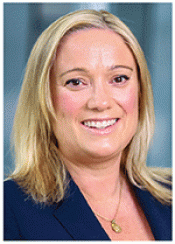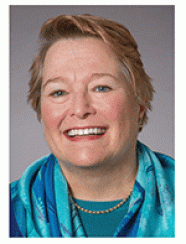To view a PDF of this report click here.
Institutional Investor interviewed Martha Peyton, Global Co-Head of Research and Head of Portfolio Management, Mark-to Market Funds, TIAA-CREF Global Real Estate in New York, and Alice Breheny, Global Co-Head of Research, TH Real Estate, in London, about how global megatrends are aff ecting real estate investors.
What are the main global megatrends, and what do they mean for real estate?
Peyton: We talk with many institutional investors who take a very long-term view of real estate. Th ey recognize the importance of shorter-term technical forecasting but also want to position themselves in a way that allows them to take advantage of these long-term structural changes in demand.
Do these megatrends apply to the U.S. as well as international markets?
P
Breheny: It’s the same story for Europe, which faces morechallenging demographics in terms of an aging population. Across the Continent younger people favor the tech-oriented cities that lead the economic growth in each country. Of course, there are structural diff erences as well. North America and Europe have more-liquid real estate markets than emerging-markets locations. Other markets, like Singapore and Hong Kong, have highly constrained land supply, which leads to higher asset pricing.
How do these trends affect real estate valuations?
Peyton: The commercial real estate market is quite efficient, but it takes more time for that efficiency to play out than in stock markets. This means that investors look at individual properties and examine their alternatives and opportunity costs. Every property has a country location whose riskless opportunity cost is the sovereign rate. In the U.S. that’s ten-year Treasuries now yielding 2 percent. So investors compare that spread versus the sovereign yield across alternative investments. That ongoing assessment keeps any one sector from getting out of control. When we buy a U.S. property, we look at the projected cash flow and likely yield going forward. Then we weed out the properties that don’t meet our criteria and focus on assets that justify their price.
How does your research function support your investment strategy?
Peyton: We conduct a layered analysis that looks at these macro drivers, structural trends and local market drivers. We want to understand where jobs are being created and whether that growth is the result of one dominant industry or a diverse cluster. Another factor in our analysis that is oft en overlooked by investors is how wealth is created and spent locally. Last, we also want to understand the factors that aff ect the supply of real estate, including land availability and ease of financing. We know that investors benefit when new construction does not overshoot the actual demand.
How can investors best diversify their portfolios within real estate? Is location or sector more important?
Breheny: To achieve diversification, you have to look carefully at both location and sector factors. For instance, if you hold assets in the financial business districts of several cities, you may only achieve a modest level of diversification. Therefore you should consider a strategy involving diff erent types of assets in various locations. We have found that an intimate local knowledge of key cities is vital in choosing which micro-locations to target.
Are new asset classes emerging within real estate?
Peyton: Th ere is a growing variety of niche property types. One of the newest involves data centers, the highly secure technology hubs that provide a key part of the infrastructure for the global interconnectedness megatrend. Another niche involves cell phone towers, which are attached to real estate and have “dirt value” as well as locational attributes that infl uence their pricing. Self-storage is another niche that has been delivering very positive performance in the current market cycle. The pharmaceuticals industry is also showing strength, which is creating more demand for specialized laboratory space. Senior housing is an asset class poised to take advantage of an aging population, and at the other end of the demographic spectrum is student housing which we have recently begun investing in. Purpose-built, amenity-rich student housing in the U.S. can off er diversification—including location, demand drivers and event risk—and attractive yields compared to other multifamily assets, but disciplined asset selection is key considering there are more than 4,700 post-secondary degree-granting institutions in the US.
Peyton: It’s the same story in Europe as well. Our researchers are looking at niche opportunities in senior housing, car parks, marinas and storage facilities, which are benefiting from the global megatrends.
How is the rise of technology affecting commercial real estate?
Peyton: Technological change has aff ected real estate since the Egyptians built the pyramids. Historically there have been periods of really epic change but in recent years we are seeing an evolution, not a revolution. In office space, the idea of “hoteling,” or sharing space continues to grow and is one driver of densified space per employee. The trend away from paper to digital storage means that law and accounting firms have much less need for traditional file rooms and libraries. This is another driver of densification. In retail, the growth of mobile devices is impacting how physical space is used to generate sales. In this market cycle more than ever before it’s important for investors to look for properties that have the capacity to adapt to these evolutionary changes.
Where do things stand in the current market cycle?
Breheny: In Europe, cities like London, Paris and Frankfurt are at a high point in the cycle, largely because of the strength of their occupational markets. However, there is no indication that rental demand is falling off. The story is diff erent in southern Europe, where while yields have moved up from the trough of the last cycle but are still comfortably adrift of their previous peak. Select locations in these markets should enjoy good occupier recovery too.
Peyton: In the U.S. the commercial real estate sector is very well balanced. Vacancy rates are below longterm averages, and construction rates are modest, so this sector is well prepared to tolerate a shock occurring in the global capital markets.
About TIAA-CREF and TH Real Estate TIAA-CREF Global Real Estate is the real estate investment and management business of TIAA-CREF. As the nation’s largest manager of U.S. institutional tax-exempt real estate assets with approximately $58 billion in assets under management, investment vehicles include directly owned properties, joint ventures, mortgages, REITs and funds. The platform has a global presence via the formation of London-based real estate asset management firm TH Real Estate, which has $28 billion in assets under management across 50 funds and mandates, bringing the combined worldwide assets under management for TIAA-CREF Global Real Estate and TH Real Estate to over $86 billion (as of 6/30/2015).
For more information about these global megatrends, download TH Real Estate’s “The Fabulous Five:” https://threalestate.com/knowledge-centre/articles/2014-10-07-the-famous-five and view TIAA-CREF’s real estate research archive: https://www.tiaa-cref.org/public/assetmanagement/insights/commentary-perspectives/white-papers
DISCLOSURES Real estate investments are subject to various risks, including fl uctuations in property values, higher expenses or lower income than expected, and potential environmental problems and liability. TIAA-CREF Asset Management provides investment advice and portfolio management services to the TIAA-CREF group of companies through the following entities: Teachers Advisors, Inc., TIAA-CREF Investment Management, LLC, TIAA-CREF Alternatives Advisors, LLC, and Teachers Insurance and Annuity Association of America. Teachers Advisors, Inc., TIAA-CREF Investment Management, LLC, and TIAA-CREF Alternatives Advisors, LLC are registered investment advisers and wholly owned subsidiary of Teachers Insurance and Annuity Associations (TIAA). Securities distributed by Teachers Personal Investors Services, Inc. C27573





